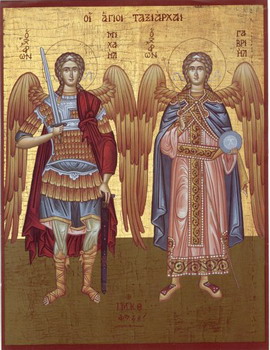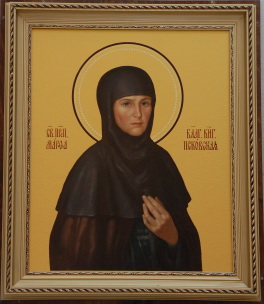|
|
+++ The Holy Archangel Michael and all the Bodiless Powers of Heaven The angels of God have been commemorated by men from the earliest times, but this commemoration often degenerates into the divinization of angels (IV Kings 23:5; A.V. II Kings). Heretics always wove fantasies round the angels. Some of them saw the angels as gods and others, if they did not so regard them, took them to be the creators of the whole visible world. The local Council in Laodicea, that was held in the fourth century, rejected in its 35th Canon the worship of angels as gods, and established the proper veneration of them. In the time of Pope Sylvester of Rome and the Alexandrian Patriarch Alexander, in the fourth century, this Feast of the Archangel Michael and the other heavenly powers was instituted, to be celebrated in November. Why in November? Because November is the ninth month after March, and it is thought that the world was created in the month of March. The ninth month after March was chosen because of the nine orders of angels that were the first created beings. St Dionysius the Areopagite, a disciple of the Apostle Paul (that Apostle who was caught up to the third heaven), writes of these nine orders in his book: "Celestial Hierarchies". These orders are as follows: six-winged Seraphim, many-eyed Cherubim, godly Thrones, Dominions, Virtues, Powers, Principalities, Archangels and Angels. The leader of the whole angelic army is the Archangel Michael. When Satan, Lucifer, fell away from God, and carried half the angels with him to destruction, then Michael arose and cried to the unfallen angels: "Let us give heed! Let us stand aright; let us stand with fear!", and the whole angelic army sang aloud: "Holy, holy, holy Lord God of Sabaoth; heaven and earth are full of Thy glory!" (See on the Archangel Michael: Joshua 5:13-15 and Jude v.9). Among the angels there rules a perfect unity of mind, of soul and of love; of total obedience of the lesser powers to the greater and of all to the holy will of God. Each nation has its guardian angel, as does each individual Christian. We must keep in mind that, whatever we do, o or in secret, we do in the presence of our guardian angel and that, on the Day of Judgement, a great multitude of the holy angels of heaven will be gathered around the throne of Christ, and the thoughts, words and deeds of every man will be laid bare before them. May God have mercy on us and save us at the prayers of the holy Archangel Michael and all the bodiless powers of heaven. Amen. The angels of God have been commemorated by men from the earliest times, but this commemoration often degenerates into the divinization of angels (IV Kings 23:5; A.V. II Kings). Heretics always wove fantasies round the angels. Some of them saw the angels as gods and others, if they did not so regard them, took them to be the creators of the whole visible world. The local Council in Laodicea, that was held in the fourth century, rejected in its 35th Canon the worship of angels as gods, and established the proper veneration of them. In the time of Pope Sylvester of Rome and the Alexandrian Patriarch Alexander, in the fourth century, this Feast of the Archangel Michael and the other heavenly powers was instituted, to be celebrated in November. Why in November? Because November is the ninth month after March, and it is thought that the world was created in the month of March. The ninth month after March was chosen because of the nine orders of angels that were the first created beings. St Dionysius the Areopagite, a disciple of the Apostle Paul (that Apostle who was caught up to the third heaven), writes of these nine orders in his book: "Celestial Hierarchies". These orders are as follows: six-winged Seraphim, many-eyed Cherubim, godly Thrones, Dominions, Virtues, Powers, Principalities, Archangels and Angels. The leader of the whole angelic army is the Archangel Michael. When Satan, Lucifer, fell away from God, and carried half the angels with him to destruction, then Michael arose and cried to the unfallen angels: "Let us give heed! Let us stand aright; let us stand with fear!", and the whole angelic army sang aloud: "Holy, holy, holy Lord God of Sabaoth; heaven and earth are full of Thy glory!" (See on the Archangel Michael: Joshua 5:13-15 and Jude v.9). Among the angels there rules a perfect unity of mind, of soul and of love; of total obedience of the lesser powers to the greater and of all to the holy will of God. Each nation has its guardian angel, as does each individual Christian. We must keep in mind that, whatever we do, o or in secret, we do in the presence of our guardian angel and that, on the Day of Judgement, a great multitude of the holy angels of heaven will be gathered around the throne of Christ, and the thoughts, words and deeds of every man will be laid bare before them. May God have mercy on us and save us at the prayers of the holy Archangel Michael and all the bodiless powers of heaven. Amen.Righteous Martha, princess of Pskov (1300) Martha of Pskov, the wife of St. Dovmont (Timothy), Prince of Pskov (May 20), was tonsured a nun in the Pskov Forerunner Monastery. She died in 1300. Martha of Pskov, the wife of St. Dovmont (Timothy), Prince of Pskov (May 20), was tonsured a nun in the Pskov Forerunner Monastery. She died in 1300. |